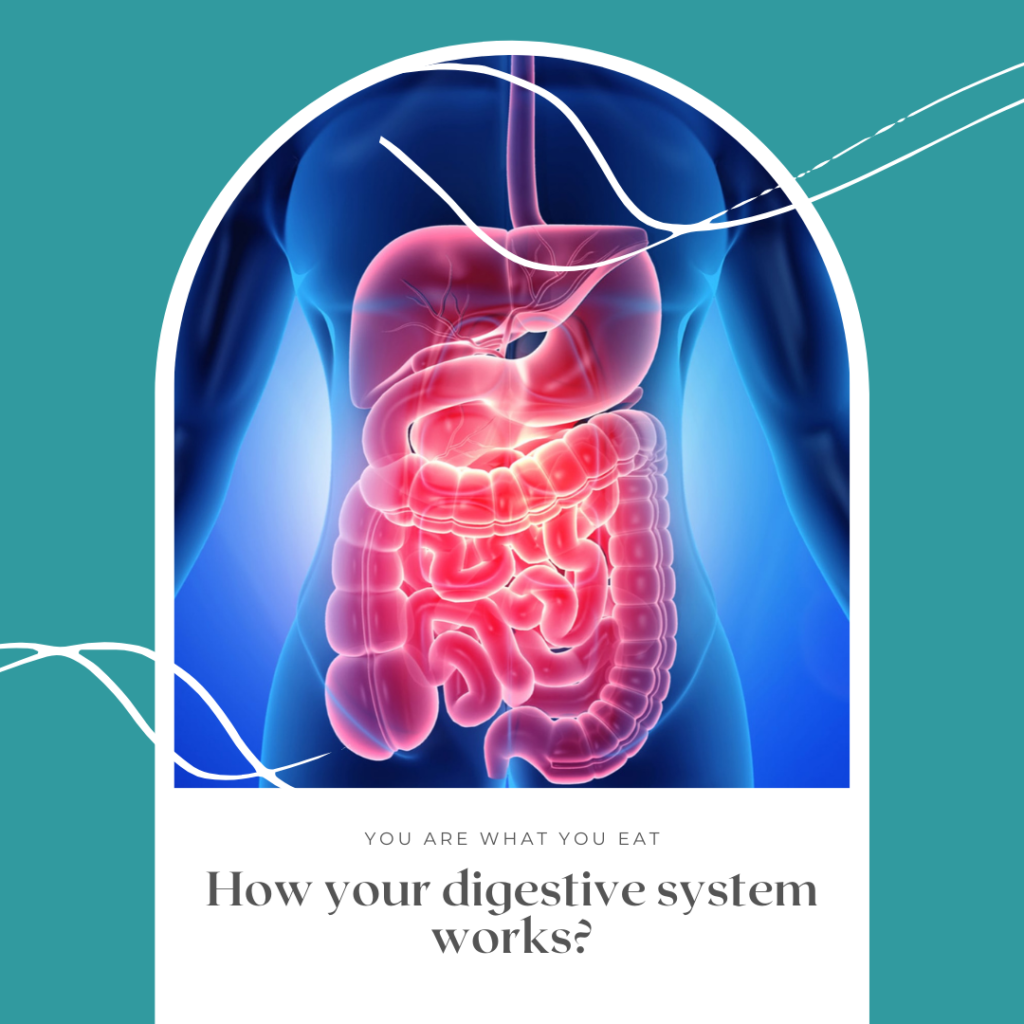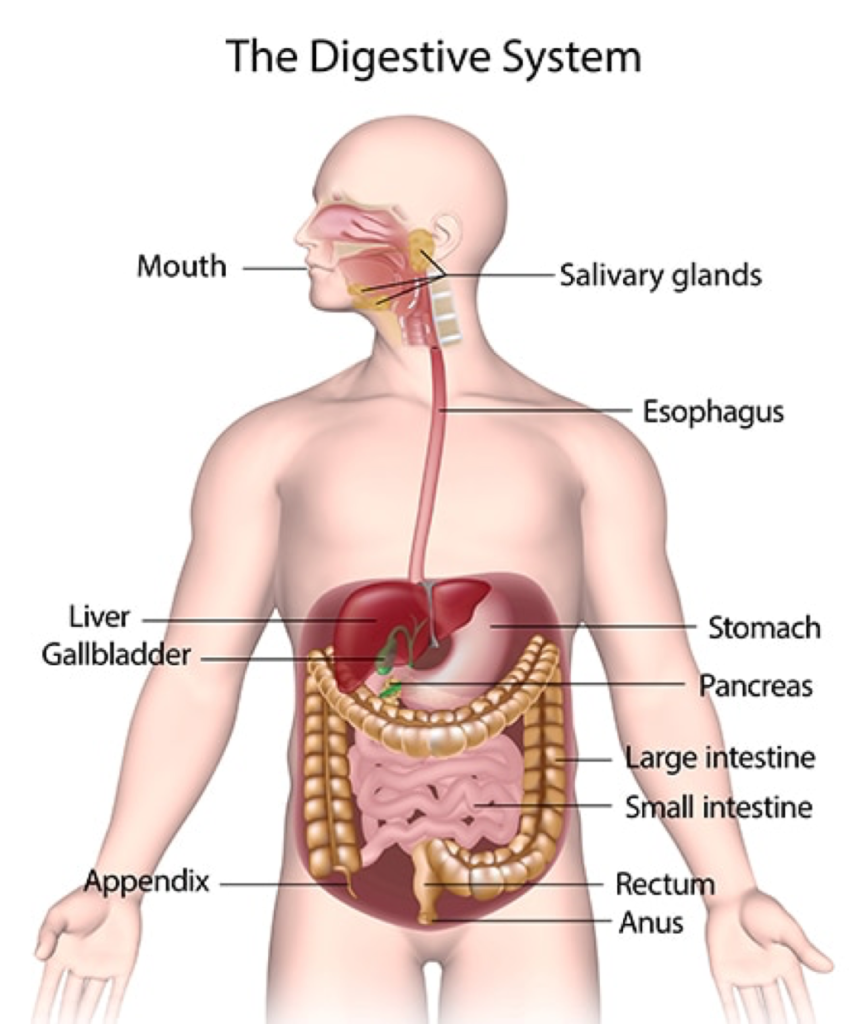

Since all I’m posting articles about health, wellness, nutrition and food. I thought it is significant to explain how our digestive system works as it is an INTEGRAL part of our overall health. Our digestive system is the first system that gets in contact with everything we swallow and enters our body. That why they say “you are what you eat”. Everything we eat and enters our body does not merely determine our physical being. However, it determines our overall health.
Digestion is the process by which food gets broken down into really small items called nutrients, such as glucose, amino acids, vitamins and minerals. This process takes place in the Gastrointestinal tract, basically means stomach and intestines (part of digestive system). Moreover, digestion is accomplished by both mechanical and chemical processes so the nutrients can be extracted then absorbed into the blood stream and distributed throughout the body. This process is not simple and involves highly complex interactions between many different acids, enzymes, hormones and other items.
In this post I want to share some details that aren’t so familiar in a simple way. Our body is complex and never works by its own. Every system have connections and interactions with other systems and organs. These interactions can’t be explained in one post, but are fascinating to know…
What is digestive system consisting of?
Since digestion starts from mouth and ends at anus. Everything in this line is considered part of the digestive system.
- Mouth: it is where digestion begins. Starts with the act of chewing and making food into smaller pieces, mixing it with saliva (released as soon as food enters and even before (sight, smell, presence of food). All helps in moistening the food that eases the movement of the food down to the rest of organs. Furthermore, the digestion of the carbohydrates starts at the mouth.
- Esophagus: muscular tube, so delicate, at the back of the throat. Initiates peristalsis (movement of the food down to the stomach). Till it reached LES (low esophageal sphincter), which is like a gate to the stomach. It opens when food reaches the end of the esophagus and closes when ALL the food enters the stomach. It is so important if it weakens because of any reason, stomach acid flow back causing problems that have negative consequences on out health.
- Stomach: large, muscular, mixes the chewed and swallowed food with number of enzymes and digestive juices and initiates the release of hormones. I have been told that it works as a washing machine. It is so dynamic as soon as foods. Besides, it has 4 major functions: 1. Storage reservoir for a short time for food 2. Food processing 3. Nutrient extractions and digestion 4.Transfer to small intestines. Stomach consists of different types of cells where all have specific functions as some responsible for secreting HCL (stomach acid) and others for secreting enzymes and different types of hormones that are related to our hunger and satiety feeling. Read more in are you really hungry?
- Small intestines: receives the chyme (digested food from the stomach) from the stomach, and it is where most digestion and absorption happens. Especially fat digestion.
- Large intestines: commonly known as colon where absorption process continues to happens, especially for undigested nutrients like fiber. Bacteria in our body mostly in our colon, which are responsible to deal with these undigested materials
These are the main parts of the digestive system. But they are not alone. There still other organs that are involved in digestion process like liver, gallbladder, pancreas, rectum and anus. All which assure the completion of digestion and absorption of the nutrients.
How it works?

- The simple way to explain how our digestive system works and it is probably what we all know. Food enters our body via mouth. We chew, swallow, and then food passes into the stomach and intestines where the digestion occurs and then the nutrients gets absorbed and delivered to other systems and organs. However, digestive system is much more complex and a lot happens in there.
- After we swallow the food, the food moves down to the stomach as a result of contraction in esophagus called peristalsis till it reaches the stomach and the gate opens.
- When food enters the stomach. The stomach stretches that is then sensed by the nerves. Which signals the release of various hormones in a coordinated order that helps in regulating the release of stomach acid (HCL), release other digestive juices, enzymes and other required items to liquefy and mix food contents.
- Chyme is the result (mixed and acidified food). Where it is pushed down to the second gate. The gate is briefly opened and allows small portions to enter the small intestine.
- Digestion is completed in the small intestines. Where enzymes and digestive juices are released from the liver and pancreases plays a role here. Now nutrients are ready to be absorbed, and they get absorbed to the blood stream to be delivered where it needs. The remaining are pushed to the large intestines.
- The remaining at this points are fluids and some minerals and fiber. Minerals get absorbed. The fiber get fermented by the bacteria. Read more in what is fiber?
- The waste is then excreted out of the body.
GI Micro-biome
Our digestive system is a home for diverse microorganisms, and they are good for our health. What I mean by microorganisms is bacteria, fungus and viruses, but don’t worry they don’t make us sick J However, they are really essential for health and especially for digestive system health.
We have about 640 species of bacteria in our digestive system. Mostly in our colon as they (bacteria can’t stand stomach acidity). These bacteria play a role in protecting our gut from infections or any other disease. they play a role in our immunity. A study on poultry found that those who are germ free were more susceptible to diseases and infections compared to normal ones (with the microbiome).
Nevertheless, these micro-biomes are essential for digesting anything that the stomach and small intestine couldn’t digest. Such as fiber, and starches (as potato .. read more in are potato bad for us?). They are like food for our good gut bacteria. They are called PREBIOTICS. Interesting fact…As we eat them and the bacteria ferments them (digest), they release substances that lower the bad bacteria. Moreover, “growing research on these released substances explores their wide-ranging effects on health, including stimulating immune cell activity and maintaining normal blood levels of glucose and cholesterol”.
Clearly, our gut micro-biome is vital for our health, we need to ensure their availability and that’s by taking PROBIOTICS. They are foods that naturally contain microbiota, mostly fermented food like yogurt, pickled vegetables, kimchi…etc. Or you can take supplement pills that contain live active bacteria. Gut micro-biome is a really broad topic that a lot needs to be cautiously noted. Keep checking the site as I’m going for sure write about it…
These are the most important parts of the digestive tract. However, there are not all. If we took a closer look at each organ, we will find that all made in a way and its structure help its functions. All of which made of specified cells and muscles. All of which release various hormones and enzymes serve the digestion and absorption processes.
Moreover, the circle does not stop here… when the nutrient gets into the blood stream. It circulates all over our body, distributing the nutrients based on the NEEDS. Since it does not end up here and everything we eat is distributed to our rest of our body, OUR FOOD CHOICES MATTERS. To assure proper function and energy not just for short time but also for lifetime.
Reference:
Rolfes, S. R., Pinna, K., & Whitney, E. (2014). Understanding normal and clinical nutrition.
Cengage learning.
Choct, M. (2009). Managing gut health through nutrition. British poultry science, 50(1), 9-15.
Wright, J. V., & Lenard, L. (2001). Why stomach acid is good for you: natural relief from
heartburn, indigestion, reflux and GERD. Rowman & Littlefield.
The Microbiome

Pingback: The importance of digestive system - nutritiousinfo
Excellent post. I definitely appreciate this website. Thanks!
Thanks so much <3